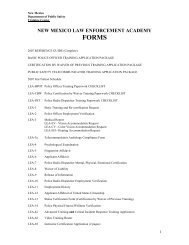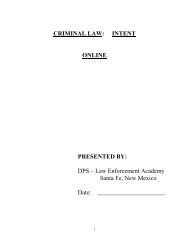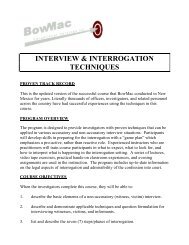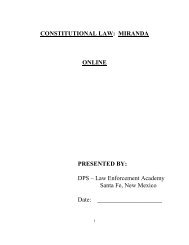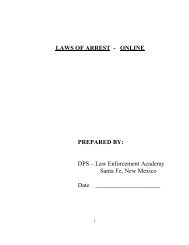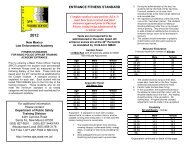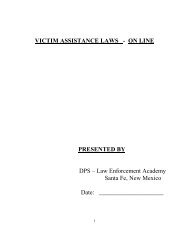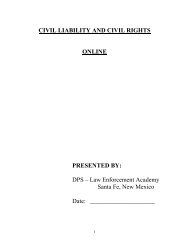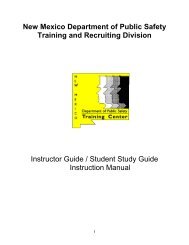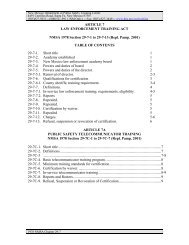10.29.1 nmac 1 title 10 public safety and law enforcement chapter ...
10.29.1 nmac 1 title 10 public safety and law enforcement chapter ...
10.29.1 nmac 1 title 10 public safety and law enforcement chapter ...
Create successful ePaper yourself
Turn your PDF publications into a flip-book with our unique Google optimized e-Paper software.
(1) Curriculum which must correspond with the current minimum st<strong>and</strong>ards of training for the<br />
requested program as set forth in <strong>10</strong>.29.9.8 <strong>and</strong> <strong>10</strong>.29.8.8 NMAC. Curriculum is subject to change at the discretion<br />
of the New Mexico <strong>law</strong> <strong>enforcement</strong> academy board.<br />
(2) List of department of <strong>public</strong> <strong>safety</strong> training <strong>and</strong> recruiting division certified instructors <strong>and</strong> their<br />
assigned course(s). Instructors must be certified through the department of <strong>public</strong> <strong>safety</strong> training <strong>and</strong> recruiting<br />
division, or instruction conducted by a non-certified instructor must be monitored by the department of <strong>public</strong> <strong>safety</strong><br />
training <strong>and</strong> recruiting division certified instructor. Technical or high risk areas must be instructed by certified<br />
department of <strong>public</strong> <strong>safety</strong> training <strong>and</strong> recruiting division instructors; for example, firearms training - qualification<br />
must be conducted by a certified department of <strong>public</strong> <strong>safety</strong> training <strong>and</strong> recruiting division firearms instructor.<br />
(3) Schedule of classes for the entire training period.<br />
(4) Roster of students' full names, dates of birth, <strong>and</strong> social security numbers.<br />
C. For New Mexico police officer transition training program, comparable training facilities for the<br />
below listed proficiency areas must be available or contracted for by the requesting agency or instructor <strong>and</strong><br />
inspected by the department of <strong>public</strong> <strong>safety</strong> training <strong>and</strong> recruiting division prior to approval.<br />
(1) Comparable driving track facility.<br />
(2) Comparable firearms range facility.<br />
(3) Comparable obstacle/agility course facility.<br />
D. Upon receipt of this information, a thorough evaluation will be made <strong>and</strong> notification sent to the<br />
regional academy advising the decision of the department of <strong>public</strong> <strong>safety</strong> training <strong>and</strong> recruiting division. In the<br />
event that the program is not approved, notification <strong>and</strong> recommendations will be sent advising the agency or<br />
institution of the program deficiencies. Once these deficiencies have been corrected, the program will again be<br />
examined <strong>and</strong> notification will be sent as to final disposition.<br />
E. Once approval is granted, the agency or institution can conduct the program with the assurance<br />
that the program is comparable to or exceeds the minimum st<strong>and</strong>ards of training as established by the New Mexico<br />
<strong>law</strong> <strong>enforcement</strong> academy board. Any deviation from the previously approved program must be submitted to the<br />
department of <strong>public</strong> <strong>safety</strong> training <strong>and</strong> recruiting division for review <strong>and</strong> approval pending final certification of the<br />
program conducted.<br />
F. 60 days prior to the regional academy start date, all fitness assessment scores, <strong>and</strong> the phase one<br />
student application packet shall be received by the department of <strong>public</strong> <strong>safety</strong> training <strong>and</strong> recruiting division.<br />
G. Class size will be determined by each regional academy, however, an appropriate instructor to<br />
student ratio must be maintained. This is especially important in the critical skill areas of physical fitness, firearms,<br />
defensive tactics, emergency vehicle operations, <strong>and</strong> situational training exercises. The certification of students<br />
completing an academy program is important. A low certification percentage, as determined by the board, will be<br />
grounds for non-renewal of academy accreditation.<br />
H. The board will establish minimum guidelines for instructor <strong>and</strong> student conduct.<br />
I. The board will determine which academies are authorized to conduct transition <strong>law</strong> <strong>enforcement</strong><br />
training. The type of student allowed to attend a satellite academy transition training program must meet the criteria<br />
listed on form LEA-1A.<br />
[<strong>10</strong>.29.8.17 NMAC - N, 11/30/09]<br />
<strong>10</strong>.29.8.18 PROGRAM COMPLETION: Upon completion of the satellite program, the agency/institution<br />
must provide the following information to the department of <strong>public</strong> <strong>safety</strong> training <strong>and</strong> recruiting division prior to<br />
administration of the <strong>law</strong> <strong>enforcement</strong> officer certification examination (LEOCE).<br />
A. Phase two application forms for certification <strong>and</strong> all necessary paperwork shall be submitted no<br />
less than six months prior to the projected completion of the basic training program.<br />
B. Final (revised) student roster: full name, date of birth, social security number, <strong>and</strong> mailing address<br />
of each student.<br />
C. Final (revised) class schedule: dates, time, <strong>and</strong> length of instruction. Each block of the minimum<br />
st<strong>and</strong>ards of training will be included.<br />
D. Final (revised) listing of instructors: instructors must be certified through the department of <strong>public</strong><br />
<strong>safety</strong> training <strong>and</strong> recruiting division certified instructor. Technical or high risk areas must be instructed by a<br />
certified department of <strong>public</strong> <strong>safety</strong> training <strong>and</strong> recruiting division instructor for the specific areas instructed;<br />
example, firearms training - qualification must be conducted by a certified department of <strong>public</strong> <strong>safety</strong> training <strong>and</strong><br />
recruiting division firearms instructor.<br />
E. Block test scores must be provided for each instructional area, as well as scoring for the skill<br />
proficiency areas, i.e., firearms, defensive tactics, patrol fitness (1.5 mile run <strong>and</strong> obstacle course), <strong>and</strong> driving<br />
<strong>10</strong>.29.8 NMAC 5



